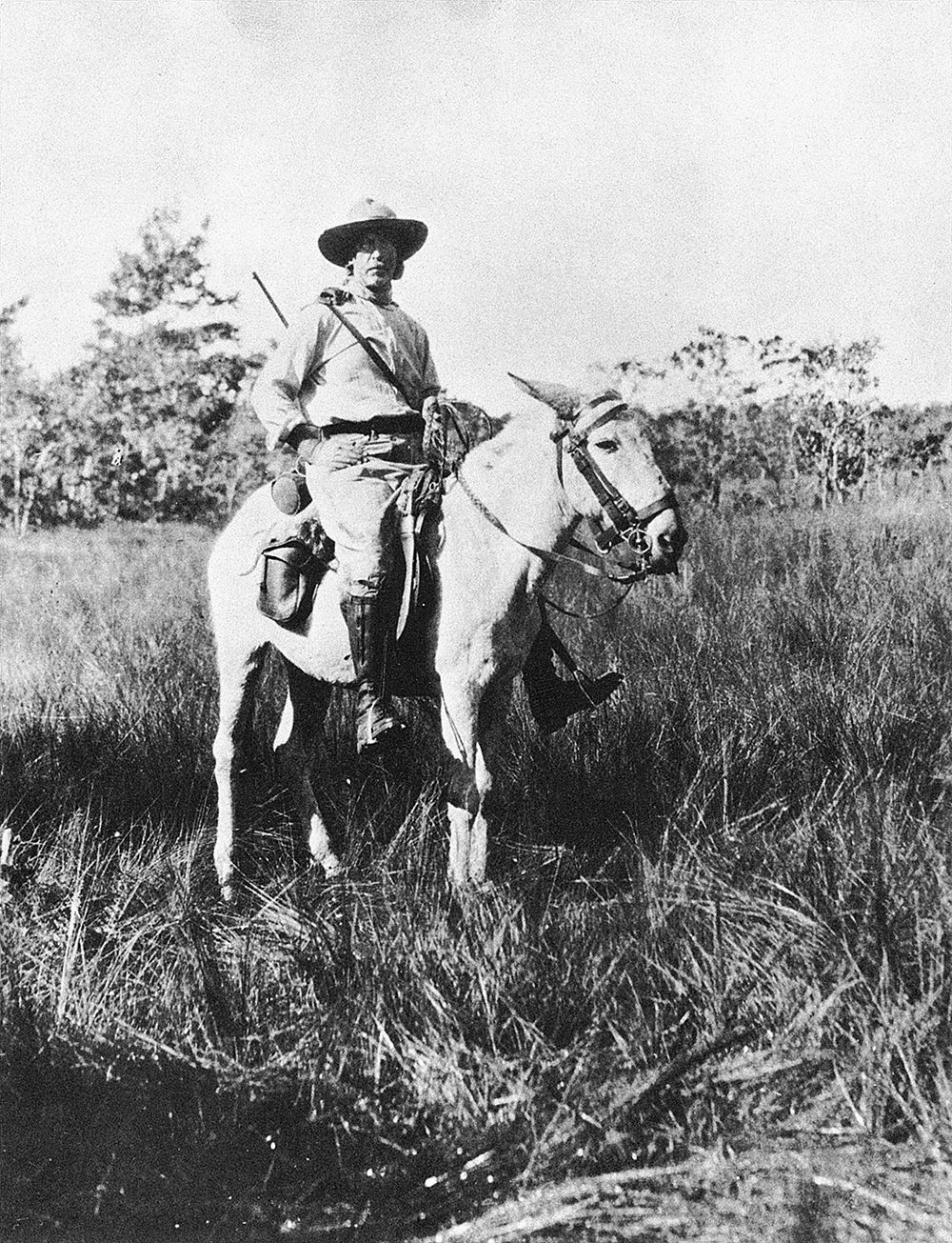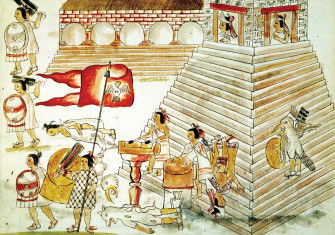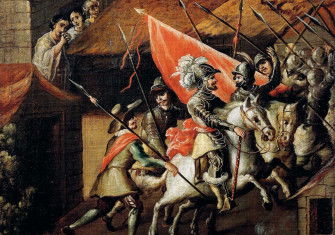Percy Fawcett and the Lost City
First Tenochtitlán, then Cuzco, then Machu Picchu – why shouldn’t cities paved with gold be discovered in South America? At least Percy Fawcett believed so.

No one knows what became of Lt. Col. Percy Fawcett. He was last seen alive on 29 May 1925, at a place known as ‘Dead Horse Camp’, somewhere in the Mato Grosso region of Brazil. For the past few months, Fawcett had been trekking through the jungle with his son Jack, Jack’s friend Raleigh Rimell and a pair of local guides in search of a lost city. It had been tough going. Though they had so far only crossed the cerrado (‘dry forest’), they had already had to contend with treacherous gorges, hunger and sickness – not to mention the threat of attack from indigenous peoples. But even greater challenges lay ahead. If, by some miracle, they made it down the Xingu River, they would have to pass through the lands of the Xavante, who were reputed to ‘kill anyone they [could] catch’. Beyond that, who could say? No European had ever been there and returned to tell the tale. For Fawcett, none of that mattered, though. After writing letters to their loved ones, he and his companions dismissed their guides and disappeared into the undergrowth – never to be seen again.
Destiny?
Born in 1867 into an aristocratic, if impecunious, family, Percy Fawcett had adventure in his blood. His father, Edward Fawcett, was a brilliant cricketer and equerry to the future Edward VII; his older brother was a Buddhist, a mountaineer and an adventure writer. At the age of 17, Fawcett was sent to the Royal Military Academy, Woolwich, where he learned ‘to regard the risk of death as the most piquant sauce to life’. On graduating, he was commissioned into the Royal Artillery and, in 1888, was posted to Ceylon. One day, the colonial administrator gave him a strange map, which seemed to show the way to buried treasure. Fawcett could hardly resist. As soon as he could, he rushed off into the interior. Unsurprisingly, all he found were rocks. But far from being disappointed, Fawcett was exhilarated. This, he realised, was what he wanted to do.
In 1901, Fawcett joined the Royal Geographical Society (RGS), intent on devoting his life to exploration. Renowned as the cradle of Victorian discovery, the RGS had already nurtured some of the most illustrious explorers of the day, including David Livingstone and Henry Morton Stanley. Fawcett could not help dreaming of a similar glory.
Soon enough, he was put to the test. In 1902, he was sent to Morocco, officially as a cartographer, but really to spy on the sultan for the British government. This went so well that, in early 1906, the RGS gave Fawcett the job of settling a border dispute between Bolivia and Brazil by mapping an uncharted area of jungle between the two. It was a long, dangerous expedition, featuring giant snakes, flesh-eating piranhas and murderous slavers. But for Fawcett, it was a triumph. What the RGS expected to take two years, he completed in just a few months. He kept up a frenetic pace even in the most hostile terrain, was oblivious to physical discomfort and seemed immune to diseases. Even he marvelled at his stamina.
From then on, the Amazon became his obsession. With each expedition, he fell ever more under its spell. In 1908, he set off to find the source of the Rio Verde. Along the way, he was threatened with mutiny and nearly starved to death – but provided Arthur Conan Doyle with the inspiration for The Lost World. Two years later, he set off to explore the jungle along the Peru-Bolivia border with the polar explorer James Murray. This was a disaster. Struggling with the tropical climate, Murray quickly became ill. Fawcett reluctantly turned back so he could return – only for Murray mistakenly to be given up for dead. By rights, this should have given Fawcett pause. But by then, he was already in the grip of a lost city he called ‘Z’.
‘Z’
The idea of a ‘lost’ city was not new. Since the days of the first conquistadores, the European imagination had been haunted by the myth of El Dorado. In his Historia general y natural de las Indias (1535), Gonzalo Fernández de Oviedo y Valdés related that, somewhere in the Amazon, there was a great lord who went about ‘continually covered with gold dust’; and it was reasonably supposed that his capital must be just as rich. Such a place did not seem implausible. In 1519, Hernán Cortés had conquered the Aztec capital of Tenochtitlán; and just 14 years later Francisco Pizarro had captured the Inca city of Cuzco, each rich beyond imagining. So why not another city elsewhere? In 1541, Pizarro’s half-brother Gonzalo, encouraged by accounts confirming Oviedo’s story, launched the first expedition to find it in 1541 – and, despite a total lack of success, many others soon followed.
By the early 20th century, most people had given up on the idea. What evidence was there, after all? The accounts of conquistadores like Oviedo were not only wildly fanciful, but contradictory. Many explorers doubted that such a city was even possible: the environment was simply too hostile. Though it teemed with life, there were few obvious sources of food. It was inconceivable that it could support a town, let alone a city. Then there were the natives. Even at the height of the El Dorado craze, people had doubted they were sophisticated enough to build on such a scale. Shocked by the ‘crudeness’ of Amazonian tribes, theologians like Juan Ginés de Sepúlveda concluded that they were ‘less’ than human. Not everyone agreed, of course. Bartolomé de Las Casas vehemently defended their status as men. But even he had a low opinion of their abilities. Rather than viewing them as ‘half-humans’, he regarded them as ‘noble savages’ – a simple, even innocent people, wholly ignorant of urban living.
Fawcett, too, thought El Dorado a romantic nonsense. But he could not help wondering whether something might be out there all the same. During his years trekking through the jungle, he had come to understand the Amazon. He knew that, if the jungle seemed hostile, it was not because there was nothing to eat, but because Europeans had no idea how to live off the land. The Amazonian tribes, by contrast, lived better than most believed. Far from eking out a meagre existence, they often set aside great stores of food and had discovered remedies for afflictions many regarded as incurable. Granted, this did not mean that Fawcett was free of prejudices. He still believed that the sophistication of some tribes was due to their being ‘whiter’ than others. But he was nevertheless convinced that the jungle could support complex cultures – and that the indigenous peoples were capable of building vast civilisations where no European had yet ventured.
There was something about the conquistadores’ accounts too. Though they were wrong about El Dorado, it was striking that most of them talked about towns overflowing with food, cities and even palaces. True, no trace had yet been found. But if all this was nonsense, why were their accounts so similar? Why did they invent so many identical fantasies? There must have been at least some truth in them, Fawcett reasoned. This seemed to be validated when, in 1911, the American explorer Hiram Bingham III rediscovered Machu Picchu, high in the Peruvian Andes. This vast mountain complex had been lost for hundreds of years; and it proved that large cities could remain hidden in remote parts of the jungle.
Intrigued, Fawcett began interviewing indigenous peoples and sifting through any evidence he could find. By 1914, he was convinced not merely that there was an ancient city out there, but that it was likely to be found somewhere near the Xingu River in the Brazilian Mato Grosso.
Into the unknown
The outbreak of the First World War forced Fawcett to put his quest on hold. Despite being almost 50, he volunteered to serve on the Western Front and fought with characteristic bravery. But the moment peace was declared he raced back to South America to continue the search. In the National Library of Brazil, he found a curious document purportedly written by a Portuguese slaver, which appeared to recount the discovery of a ruined metropolis in 1753. From this he concluded that there might even be more than one ancient city waiting to be discovered. More convinced than ever, he mounted a first expedition to ‘Z’ in 1920. This proved a miserable failure. But in 1924 he was ready to try again, this time with Jack and Raleigh. They travelled light, with only the barest essentials, and Fawcett drove the little party as hard as he dared. His last letter brimmed with confidence. ‘You need have no fear of failure’, he told his wife. Then, just as Z seemed within reach, he vanished.
Three years later, the RGS declared Fawcett lost. Over the years to come, tantalising traces of his expedition turned up: a nameplate in 1927, a theodolite in 1933, even his signet ring in 1979. What happened to him remains a mystery. Some think he may have been set upon by bandits. Others that he decided to make the Amazon his home. Most likely, he was simply killed by hostile tribes – the victim of his own misguided over-confidence.
Why, then, should we care about Fawcett? He is not a sympathetic figure. John Hemming has described him as an ‘unimportant, disagreeable, and ultimately pathetic man’. His dreams of a ‘lost’ city turned out to be nonsense – as fanciful and absurd in retrospect as El Dorado. His death was, at best, futile; at worst, a cruel parody of the misconceptions he tried to correct.
Yet the search for ‘lost’ or even imagined cities should not be lightly dismissed. All explorers start out like Fawcett, to some extent. The only thing that distinguishes the ill-starred genius from the visionary crackpot is success – or, rather, failure. It is the dream that animates them all; without it, no exploration is possible. And without exploration, what hope is there for wonder?
Alexander Lee is a fellow in the Centre for the Study of the Renaissance at the University of Warwick. His latest book, Machiavelli: His Life and Times, is now available in paperback.






